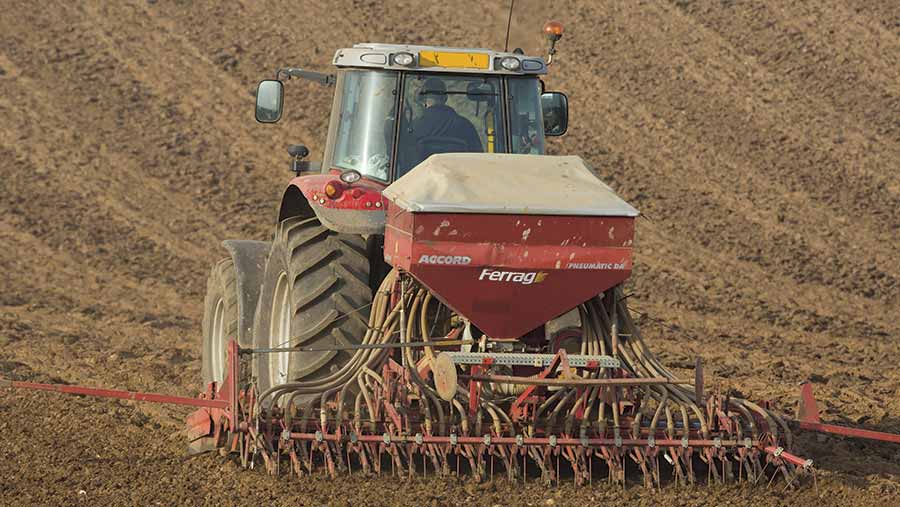Crop Watch: Wet weather leads to spring task slowdown
 © Tim Scrivener
© Tim Scrivener Our agronomists have seen a slowdown in spring tasks this week, with efforts hampered by recent wet weather, and thoughts are now turning to the task of disease control in cereals.
In the west, Antony Wade blames mild autumn temperatures over successive seasons for the increasing incidence rates of clubroot.
Where weather permits, and crops aren’t too forward, sprayer operators are now under starters orders for weed control in oilseed rape, says Marion Self, as the clopyralid open season began on 1 March.
Richard Harding reminds southern growers on lighter land that they will frequently need to correct micronutrient deficiencies, but shortcomings can be detected with a leaf tissue sample.
Malting barley growers in the north who haven’t yet selected which variety to grow this season should take another look at the new varieties on offer, says Mary Munro, because they’re higher yielding and have a better disease resistance profile.

West: Antony Wade
AICC (Herefordshire/Shropshire)
Oilseed rape crops that were large in the autumn have been held back well by the autumn tebuconazole, and the canopies have opened up so that they are not too oversized for the start of spring growth.
I have been incubating leaves for light leaf spot since early January, but the predicted epidemic has been slow to take off – only in the last two weeks have symptoms started to show.
So recommendations have gone out to try to get some protectant fungicide on, because this is the only situation where you get good activity from the chemistry.
I have been really pleased with the control of cranesbill and charlock from 0.5l/ha of bifenox in the autumn, in combination with the frosts.
The split programme approach is usually necessary, but some fields this season won’t need the second split of a further 1l/ha.
Even since my last report in November further clubroot patches have appeared in crops that had been fine before Christmas.
Talking to other agronomists this is becoming a fairly widespread problem in the west, following two autumns with conducive soil temperatures for development.
Winter wheat weeds
Wheat crops have carried on tillering and growing throughout the winter – generally residual herbicides have worked pretty well. In a few fields where bromes have also continued to grow we have already applied some pyroxsulam-based contact herbicides.
As always, it is a balancing act of increasing weed size against waiting for warming soil temperatures and active growth, but the former is the driver for me.
Septoria levels are building on lower leaves especially on early drilled crops, and with recent regular heavy showers causing plenty of rain splash this will be moving up the canopy.
Mildew is also present on susceptible varieties, such as Leeds, but I have not found any yellow rust reported by others.
So it is potentially building up to be a high disease year, which will be interesting with the new fungicide offerings this season.
Unfortunately for the manufacturers, with the increased range of options and no shortage of product, the market is going to be very competitive and strategies will still need to be cost-effective.

East: Marion Self
Prime Agriculture (Suffolk)
It was a slow start to the spring workload because the weather forecast remains unsettled for early March. Frustration is mounting because growers are keen to complete first nitrogen and sulphur dressings on winter crops and to spray off winter seedbeds ahead of pulling down land for sowing spring crops.
Some of the dirtiest crops for grassweeds are early drilled wheat and barleys sprayed with pre-emergent herbicides in dry conditions.
Many of these barley growers are relying on the competitive growth of hybrid varieties to reduce seed return of the grassweeds – don’t expect too much.
This year there is a greater area of wheat varieties with more robust resistance to septoria (AHDB Recommended List rating of 6 and above), e.g. Siskin (6.8 rating).
This has promoted discussion around the level of fungicide input on these varieties. However, most varieties have a relative weakness to either septoria or rusts and will be treated with a T0 fungicide.
T0 is applied at GS 30 (approx. three weeks prior to T1) and this will usually include a dose of triazole with chlorothalonil to start rust and septoria protection.
At this time some crops may need an additional mildewicide. Keeping the bottom of the canopy clean and well protected is important, particularly now the eradicant activity of triazoles is weak.
On winter barley, more growers will consider a T0 fungicide with the first PGR application (GS 30). In the east, yield responses to this timing are not guaranteed, but applications can be very useful in delaying the timing of T1 and T2.
Without a T0, the time between T1 and T2 can become uncomfortably stretched, or the programme requires an additional late spray or ends too early.
Grassweeds control
Rapeseed sprays based on clopyralid for thistle and mayweed control can now be applied from 1 March. Check that forward crops are within the safe growth stage for application – before green buds are raised above the canopy.
Where applied, AstroKerb (propyzamide+aminopyralid) has already checked these targets and this workload is much reduced.
Most rapeseeds will receive a light leaf spot/PGR application at green bud. Straight tebuconazole offers good light leaf spot control and growth regulation, but on the biggest canopies I will be using a specific PGR such as Caryx (mepiquat chloride+metconazole) or Toprex (difenoconazole+paclobutrazol).

South: Richard Harding
Procam (Sussex)
Spring has almost sprung on the Downs, with a few drills tempted out by dry weather at the beginning of last week.
Septoria can easily be found in winter wheat, so the priority will be a well-timed triazole mix at T0 combined with chlorothalonil for a robust start to this year’s fungicide programme. A mildewicide may also be included where appropriate.
Tank mixes will be further increased where forward crops at GS 30 will require an equally robust PGR programme, beginning with the Medax Max, which contains two anti-giberellins (trinexapac-ethyl and prohexadione-calcium).
This has the ability to work well at the relatively low spring temperatures being experienced at the moment.
Micronutrient management
Follow-up tissue sampling after last autumn will now begin in earnest to identify any hidden hunger in crops and guide additional foliar nutrition may be needed.
Manganese, zinc and copper are all frequently deficient, and key to address on the chalk downland, with magnesium the other key nutrient that can also routinely be found at sub-optimum levels.
Oilseed rape crops look excellent and will soon be due to receive a stem extension fungicide applied to control light leaf spot and phoma, but which also has a beneficial PGR effect.
A product containing paclobutrazol and difenoconazole will be used with the aim being to reduce crop height, increase lateral branching, maximise light interception by the crop, and increased synchronicity of flowering to maximise yield.
Generally, cover crops have produced disappointing levels of biomass due to the dry autumn last year, but nevertheless have still performed the function of maintaining soil cover and provided a feed source for soil biology.
These covers will be now sprayed off pre- or post-drilling with a low rate of glyphosate depending on the type of drill used and density of the cover. Winter beans direct drilled in to grass have established pleasingly well and are now look promising.

North: Mary Munro
AICC/Strutt and Parker (Perthshire)
As the days lengthen and the temperatures begin to creep up it feels as though spring is around the corner.
Some action is already evident, with a lot of P and K spread recently and spring beans in the ground for some early birds.
Temperatures are on the low side – Scotland has definitely not had 18C this year – and hence the rush has not quite started.
Soils are drier than usual, though, because we have had remarkably little winter rainfall – proof if ever it were needed that no two years are the same.
Autumn-sown crops are looking incredibly well. Slug damage is less evident than usual because of the quick early growth, and dry conditions are helping curtail the slugs and allow pellets to be spread in the back-end.
Pigeons moved into oilseed rape crops a little later than normal and it is frustrating how thick a stem they will peck through.
Fresh growth is appearing and, with a bit of nitrogen, these crops will grow rapidly. Most crops got a light leaf spot spray in the autumn and disease levels are generally low. One treatment in the spring will keep them right.
New barley varieties need room to grow
We are hearing encouraging comments about the market for malting barley, and even minimum prices for contracts, which is welcome.
However the movement away from Concerto is very slow and it would be good to see some of the newer varieties doing well this season and gaining some market share. Concerto’s yield is outclassed and it has the poorest rating for rhynchosporium on the list.
I have been out and about mapping fields for Agri-environment Climate Scheme applications. It is a great way to explore every corner of a holding, and the scheme can generate some extra income for farmers.
Certainly the prospect of 10ha of overwintered stubble followed by a green manure crop, earning £780/ha per year, focuses the mind.

